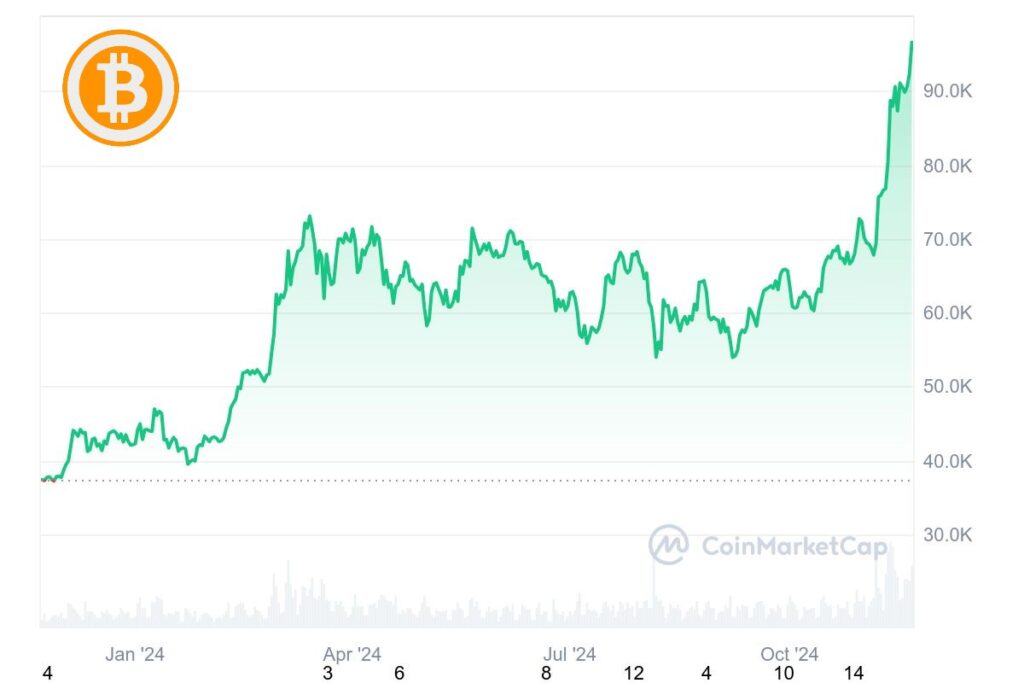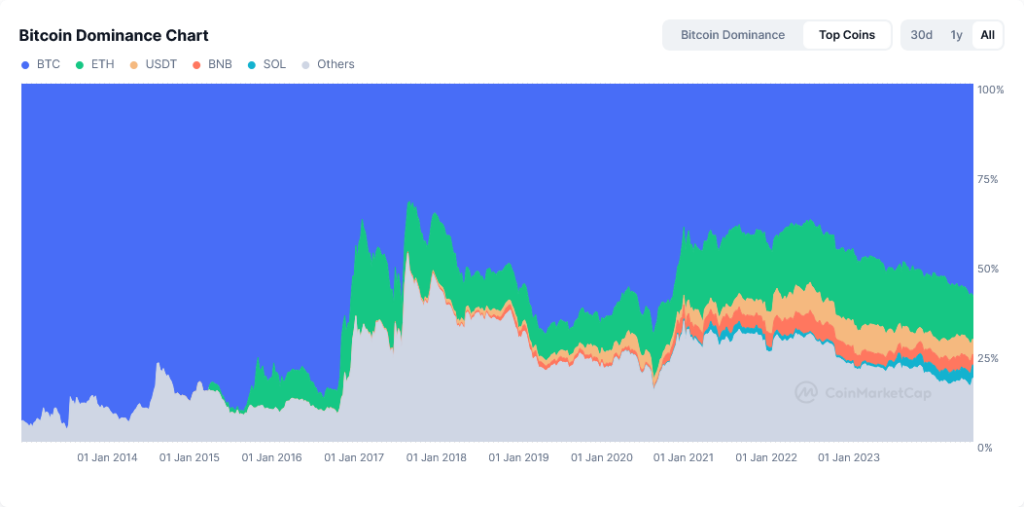Bitcoin has once again defied expectations, reaching an all-time high of $97,000 in November 2024. For seasoned investors, the climb is no surprise—historically, Bitcoin’s halving cycles have triggered significant price appreciation. But this year’s rally isn’t solely about the halving event that occurred seven months ago. A potent mix of macroeconomic uncertainty, geopolitical tensions, and institutional adoption has propelled the world’s largest cryptocurrency to new heights.
With Bitcoin edging closer to the symbolic $100,000 milestone, the question remains: Is this surge the foundation of a sustainable bull market, or merely a temporary spike driven by external forces?
Halving’s Lingering Impact: Scarcity Fuels Demand
On April 19, 2024, Bitcoin underwent its fourth halving, reducing the block reward from 6.25 BTC to 3.125 BTC. The halving event is a critical component of Bitcoin’s design. It reduces the rate at which new coins enter circulation, creating a supply shock. Historically, such events have driven demand, as seen in the months following the 2016 and 2020 halvings.
The current rally aligns with this pattern. As supply dwindles, the scarcity narrative around Bitcoin intensifies, attracting investors seeking to capitalize on the reduced issuance. However, many analysts argue that the halving alone cannot explain Bitcoin’s dramatic rise; broader economic forces are at play.

Macroeconomic Forces Amplify Bitcoin’s Appeal
Global economic instability has significantly influenced Bitcoin’s ascent. Persistently high inflation rates in major economies, coupled with rising interest rates, have eroded trust in fiat currencies and traditional investment vehicles. Bitcoin, often referred to as “digital gold,” has become a preferred store of value for those seeking a hedge against economic uncertainty.
Geopolitical tensions have also driven adoption. Escalating conflicts and economic sanctions have prompted individuals and institutions in affected regions to turn to Bitcoin as a means of wealth preservation and cross-border transactions. This trend has been particularly pronounced in countries with restrictive financial systems or volatile currencies.
Institutional Adoption: From Fringe Asset to Mainstream Investment
A defining feature of Bitcoin’s current rally is the role of institutional investors. The approval of spot Bitcoin ETFs in the United States earlier this year marked a turning point. Products like BlackRock’s iShares Bitcoin Trust have provided traditional investors with a regulated, accessible way to gain exposure to Bitcoin. That resulted in significant inflows of capital.
Institutional participation has driven Bitcoin’s dominance to over 55% of the cryptocurrency market. This dominance underscores its transition from a speculative asset to a cornerstone of modern investment portfolios. However, this influx of institutional money has raised questions about Bitcoin’s decentralization, as large players increasingly influence market dynamics.

Volatility Ahead? Risks to Bitcoin’s Momentum
While optimism abounds, potential risks could temper Bitcoin’s upward trajectory. Regulatory uncertainty remains a significant concern, particularly regarding centralized exchanges and stablecoins that underpin much of the cryptocurrency market. Additionally, profit-taking by early investors could trigger short-term corrections.
Some analysts caution that Bitcoin’s current valuation may already reflect much of the post-halving and macroeconomic momentum, leaving limited room for further upside without additional catalysts.
>>> Read more: Bitcoin Reserves On Exchanges Further Declining
Bitcoin’s rise to $97,000 is a culmination of cyclical, economic, and institutional factors. it underscores its growing relevance in the global financial ecosystem. While the April 2024 halving set the stage, the rally has been amplified by broader trends, including inflation concerns, geopolitical shifts, and increased adoption by institutional investors.
As Bitcoin inches closer to $100,000, it stands at a crossroads: Will it solidify its role as the digital gold standard, or will volatility and regulatory challenges temper its ascent? Regardless of the outcome, Bitcoin’s journey to this point is a testament to its resilience and its transformative impact on the financial world.
Readers’ frequently asked questions
What exactly is the Bitcoin halving, and why does it matter so much for its price?
The Bitcoin halving is a programmed event in Bitcoin’s code. It reduces miners’ rewards for validating transactions by half and happens roughly every four years. In April 2024, the reward dropped from 6.25 BTC to 3.125 BTC. This reduction limits the number of new bitcoins entering circulation, creating a scarcity effect. Economically, when demand stays constant or rises and supply decreases, prices tend to increase. The halving is a cornerstone of Bitcoin’s deflationary design, aimed at mimicking the scarcity of precious metals like gold. However, it’s not just the halving itself that drives prices. It’s the market’s anticipation of it, combined with broader adoption and macroeconomic factors, that ultimately contributes to price rallies.
How does institutional involvement influence Bitcoin’s price and its identity as a decentralized currency?
Institutional involvement, such as the launch of Bitcoin ETFs like BlackRock’s iShares Bitcoin Trust, introduces substantial liquidity to the market. This has a stabilizing effect on price volatility over time as larger players adopt Bitcoin as part of their diversified portfolios. However, the influx of institutional capital also changes Bitcoin’s dynamics. Critics argue that it shifts Bitcoin away from its original purpose as a peer-to-peer, decentralized currency. Instead, it turns it into more of a speculative or investment vehicle controlled by traditional financial institutions. This duality creates tension: while institutional adoption accelerates mainstream acceptance, it could centralize influence over the market and diminish the ethos of decentralization. A feature that Bitcoin’s early adopters championed.
Is Bitcoin a safe investment now, given its recent price surge?
Bitcoin’s all-time high of $97,000 demonstrates its growth potential. Still, it’s important to note that cryptocurrency remains a highly volatile asset. While the current rally reflects a combination of reduced supply post-halving, macroeconomic conditions, and institutional demand, the market is still subject to risks such as regulatory changes, profit-taking, and broader economic downturns. For investors, understanding the risks and having a long-term strategy is crucial. Bitcoin’s potential lies in its role as a hedge against inflation and as a store of value, but it’s not immune to sharp corrections. Those considering an investment should evaluate their risk tolerance and diversify their portfolios to mitigate exposure to market swings.
What Is In It For You? Action Items You Might Want to Consider
Consider Strategically Accumulating Bitcoin Before the $100K Milestone
With Bitcoin’s price nearing $100,000, traders should evaluate the potential for further growth driven by lingering effects of the April 2024 halving, ongoing institutional inflows, and macroeconomic uncertainty. If you believe these factors will sustain the rally, consider gradually increasing your Bitcoin position rather than making lump-sum purchases to mitigate the risk of short-term corrections. Look for opportunities during minor pullbacks to secure better entry points.
Diversify to Hedge Against Market Volatility
While Bitcoin’s price surge is promising, its market remains prone to volatility. Consider diversifying your portfolio by including other cryptocurrencies or assets with strong fundamentals, such as Ethereum, which often benefits from Bitcoin-led rallies, or stablecoins for liquidity management. Diversification can help you reduce risk while maintaining exposure to the crypto market’s upside potential.
Stay Alert to Regulatory Developments and Market Sentiment
The crypto market is heavily influenced by news and regulations. Keep a close eye on developments surrounding centralized exchanges, stablecoins, and ETF approvals, as these could significantly impact market conditions. Additionally, monitor market sentiment and on-chain data, such as whale activity or exchange inflows, which might signal impending price movements. Being proactive about gathering and acting on this information could give you an edge in navigating Bitcoin’s volatile journey.











[…] >>> Read more: Bitcoin High: $97K Surge Fueled by Market Forces […]